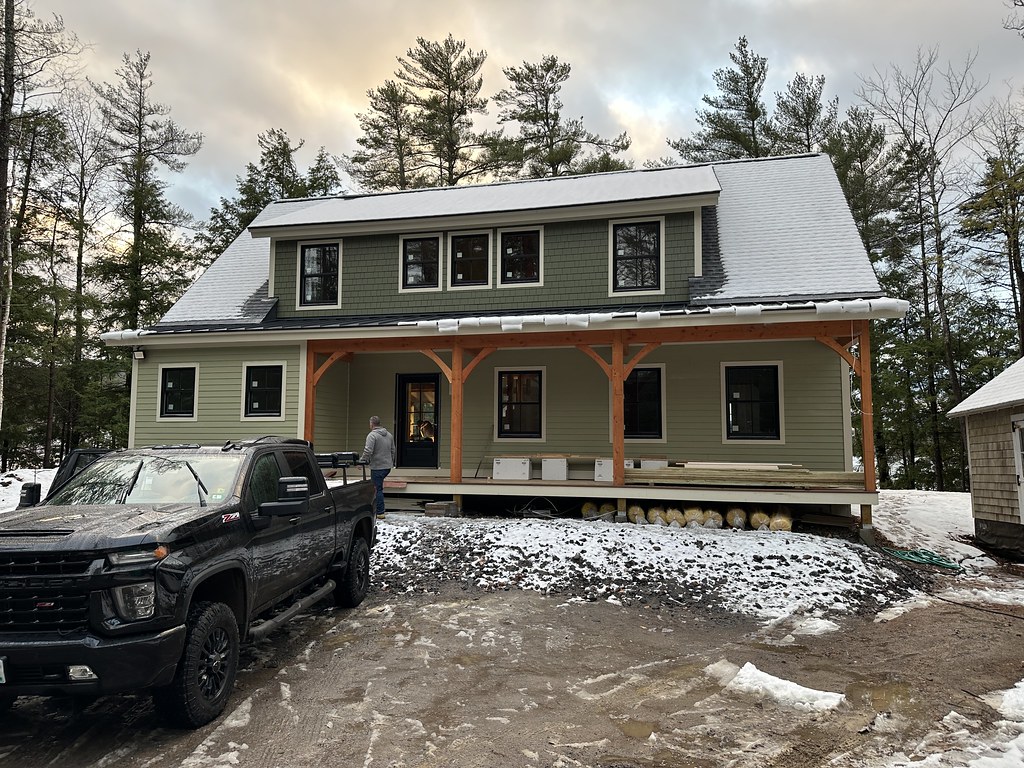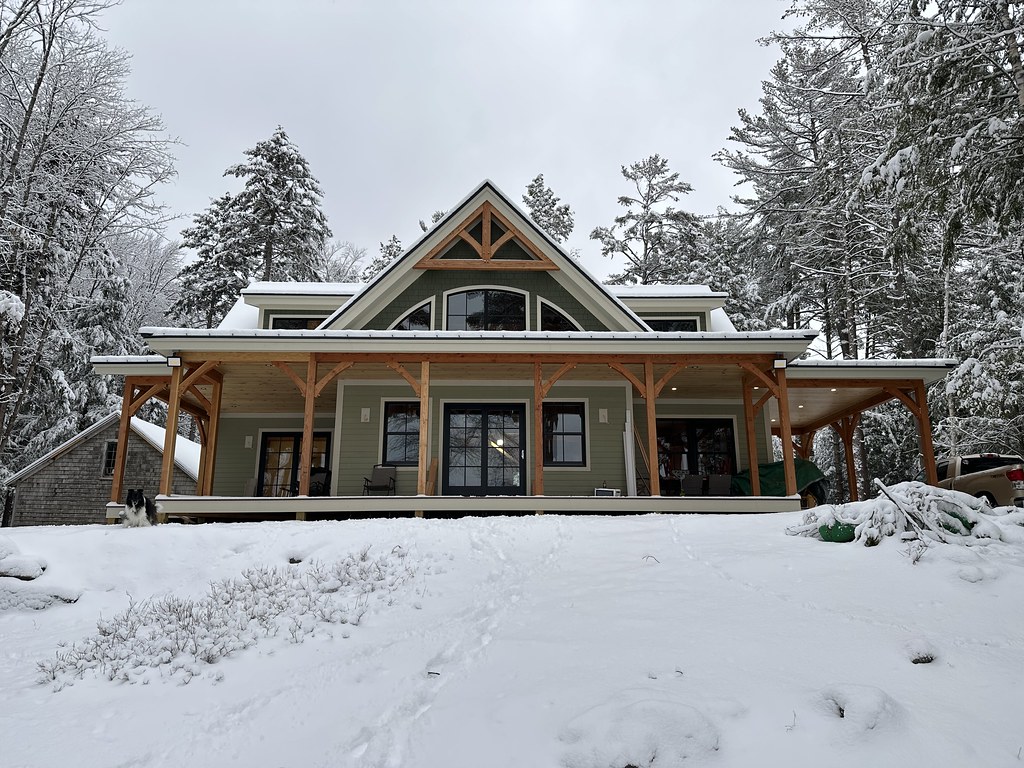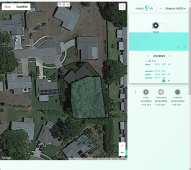Howdy folks,
Hope I've come to the right place.
Little bit of background. I had solar installed by a local company in MA ~5 years ago.
7.6kw LG Panel with SolarEdge Optimizers and Inverter.
It produced about 8 MWh and just about covered all usage. No battery with 80% Net Metering
20-25 year warranty on everything parts and labor.
Moved into a new home in NH. Knowing I will go solar I went all electric. GeoThermal, Electric Hot Water, Induction Stove, Electric Dryer.
This house is a little tricky to get solar on for a few reasons.
Has a porches around most of it with metal roof and low pitch.
Fair amount of trees. Some can be pruned. It's near water and there are strict rules.
I had large eves put on the house.
It's a Post & Beam (no attic and SIP panels for the roof (solid foam)).
I don't have a great picture but I want to use the detached garage for some of it. 24' x 20' with 12 : 12 roof (faces south).
First photo faces East (note garage on the right that I'd like to use)
Second photo faces West
I've got an estimate from SunRun $32k for 9 KW (no battery). 23 390 watt panels.
They put 15 on the Shed Roof and 8 on the garage.
I'm very concerned about punching holes through roof, and exterior pipes.
If I do it, I'll take my time and find a way to do it with taste. I might even go inside and open/create a chase for conduits.
Pretty pricey for 9 KW, 10 year warranty and below avg customer rating and below par warranty.
Tesla canceled me, twice. First time because house wasn't complete.
Second time, I'm not sure. I know it won't be the most efficient location. So ROI will be way out there, that's ok.
Another local company, wanted like $52K for 12KW system.
So now considering DIY. I have done a far amount of electrical work over the years pools, full services, all passed inspection.
What are the known good DIY companies to work with? Mostly concerned about quality of Panels/Inverters
I'd like to get the pure black panels.
With the garage detached I thought it would be easier to go with two inverters. Rather than run DC underground to the house.
There are already two 2" PVC pipes available for what's needed.
Have a Leviton 200A Panel with 225A buss plenty of room.
Currently using 1800 kWh in Jan (not very cold winter) but I have some more insulating to do.
With 440 watt panels I can get 10 KW
Inspections are pretty thin here. All they inspected for the entire house was the leach field.
I'd really like to push what I can to the limit (within reason) on the garage.
Min 10 Kw, would love 12 Kw and be in heaven with 15 Kw.
SunRun looked at ground based and they said no way. Too much shade.
Garage is old but sound, but roof needs some beefing up. True 2x6 rafters on 2ft centers.


Hope I've come to the right place.
Little bit of background. I had solar installed by a local company in MA ~5 years ago.
7.6kw LG Panel with SolarEdge Optimizers and Inverter.
It produced about 8 MWh and just about covered all usage. No battery with 80% Net Metering
20-25 year warranty on everything parts and labor.
Moved into a new home in NH. Knowing I will go solar I went all electric. GeoThermal, Electric Hot Water, Induction Stove, Electric Dryer.
This house is a little tricky to get solar on for a few reasons.
Has a porches around most of it with metal roof and low pitch.
Fair amount of trees. Some can be pruned. It's near water and there are strict rules.
I had large eves put on the house.
It's a Post & Beam (no attic and SIP panels for the roof (solid foam)).
I don't have a great picture but I want to use the detached garage for some of it. 24' x 20' with 12 : 12 roof (faces south).
First photo faces East (note garage on the right that I'd like to use)
Second photo faces West
I've got an estimate from SunRun $32k for 9 KW (no battery). 23 390 watt panels.
They put 15 on the Shed Roof and 8 on the garage.
I'm very concerned about punching holes through roof, and exterior pipes.
If I do it, I'll take my time and find a way to do it with taste. I might even go inside and open/create a chase for conduits.
Pretty pricey for 9 KW, 10 year warranty and below avg customer rating and below par warranty.
Tesla canceled me, twice. First time because house wasn't complete.
Second time, I'm not sure. I know it won't be the most efficient location. So ROI will be way out there, that's ok.
Another local company, wanted like $52K for 12KW system.
So now considering DIY. I have done a far amount of electrical work over the years pools, full services, all passed inspection.
What are the known good DIY companies to work with? Mostly concerned about quality of Panels/Inverters
I'd like to get the pure black panels.
With the garage detached I thought it would be easier to go with two inverters. Rather than run DC underground to the house.
There are already two 2" PVC pipes available for what's needed.
Have a Leviton 200A Panel with 225A buss plenty of room.
Currently using 1800 kWh in Jan (not very cold winter) but I have some more insulating to do.
With 440 watt panels I can get 10 KW
Inspections are pretty thin here. All they inspected for the entire house was the leach field.
I'd really like to push what I can to the limit (within reason) on the garage.
Min 10 Kw, would love 12 Kw and be in heaven with 15 Kw.
SunRun looked at ground based and they said no way. Too much shade.
Garage is old but sound, but roof needs some beefing up. True 2x6 rafters on 2ft centers.


Last edited:



